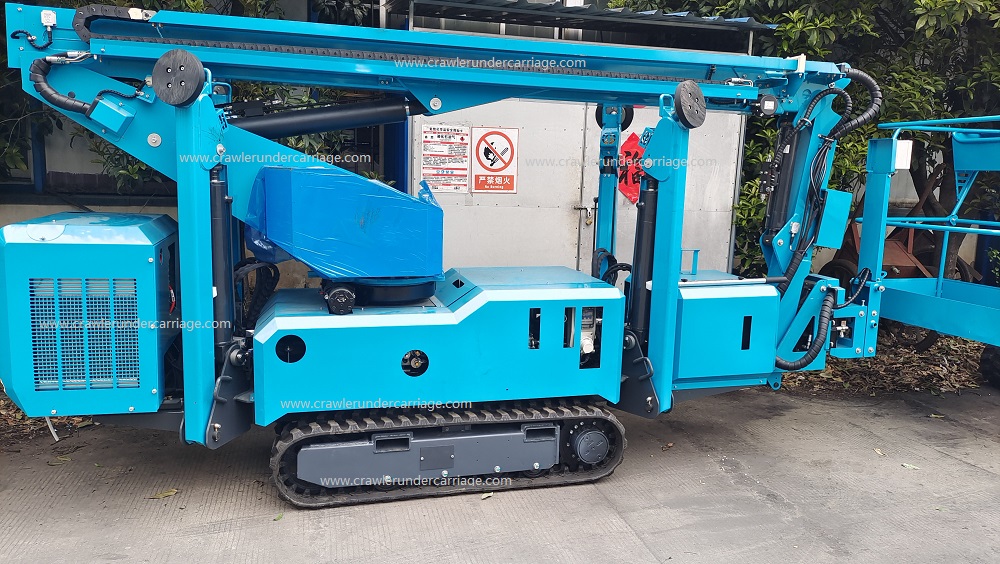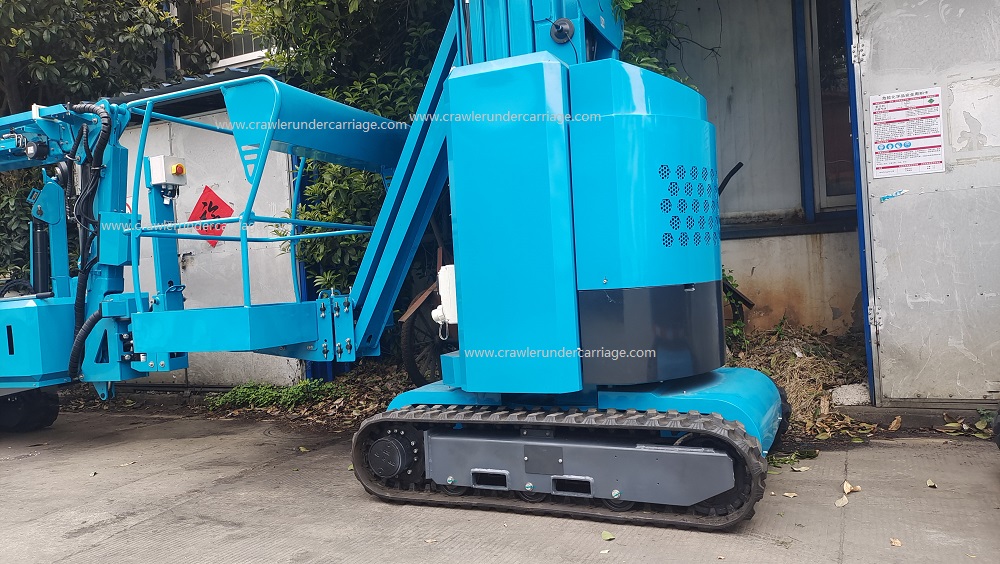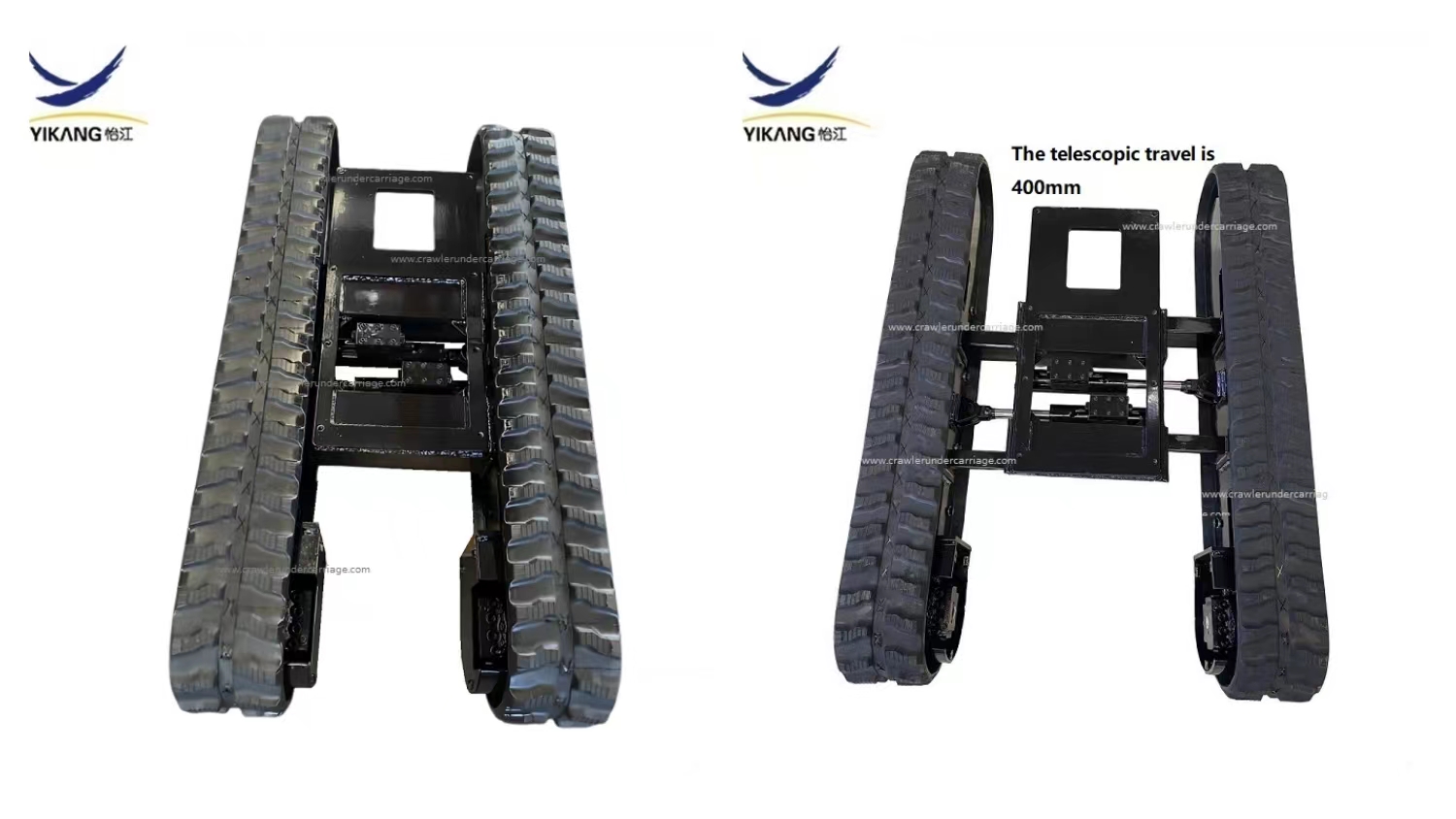The application of the telescopic crawler undercarriage on aerial work platforms (especially spider-type aerial work platforms) is a key technological innovation. It significantly enhances the adaptability and operational capabilities of the equipment in complex, restricted or uneven working conditions. The main application values and advantages of this technology are as follows:
Core Advantage
1. Outstanding maneuverability and passability:
* Passage in narrow spaces: The width of the crawler undercarriage can become extremely narrow when in the contracted state (usually less than 1 meter, or even around 0.8 meters), enabling easy passage through standard door frames, narrow corridors, elevator shafts, equipment gaps and other spaces that traditional wheeled platforms or wide crawler platforms have difficulty accessing.
* Adaptability to complex terrains: The crawler has a large contact area with the ground, exerting little pressure on it (especially in the extended state), which enables better adaptation to soft ground (such as soil, sand, grassland), uneven ground (such as gravel, slight steps, slopes), and even shallow water areas, reducing the risk of getting stuck. The telescopic function can further optimize the ground pressure and stability on different terrains.
* Universal indoor and outdoor use: The rubber crawler has minimal damage to indoor fine surfaces (such as marble, wood flooring, epoxy flooring) in the contracted state, while still providing strong passability on complex outdoor terrains, enabling one machine to serve multiple purposes.
2. Excellent stability of operation:
* Variable wheel spacing / support span: This is one of the most crucial advantages of the telescopic crawler undercarriage. When the equipment needs to be raised to a higher height or perform large-scale boom extension operations, the crawler can be extended outward, significantly increasing the lateral support span (wheel spacing) of the equipment, greatly reducing the center of gravity, and greatly enhancing the overturning stability of the entire machine. This is crucial for operations on slopes or when the platform reaches its maximum working height/extension range.
* Adaptation to uneven ground: Each crawler can usually be independently leveled. Combined with the telescopic feature, it can more effectively adapt to uneven ground, allowing the platform to maintain the level of the upper part (working platform) even on slopes or on irregular surfaces, ensuring safe and comfortable operation.
3. Low ground pressure and site protection:
* The tracks distribute the equipment's weight over a larger contact area, especially when in extended position, significantly reducing the ground pressure per unit area. This is crucial for protecting fragile surfaces such as newly laid asphalt, roofs, interior flooring, and ancient building surfaces, preventing damage or leaving deep marks.
4. High flexibility:
*Operators can adjust the width of the tracks in real time according to the space limitations on site, the ground conditions, and the requirements for working height/extension, by contracting to pass through narrow areas or protecting the ground, and extending to achieve the best stability, without the need for additional tools or auxiliary equipment.
Selection and Consideration Factors
* Maximum working height/extension: The higher the working height and the greater the extension, the higher the requirement for chassis stability. Choosing a model with sufficient stretching width capability is crucial.
* Minimum turning width: Select the chassis width after contraction based on the smallest width of the narrowest passage in the target working condition.
* Slope climbing ability: Track chassis usually has better slope climbing ability than wheeled ones (commonly 30%-45% or higher), but specific values need to be confirmed.
* Ground protection requirements: If mainly used indoors or on fine surfaces, rubber tracks and low ground pressure are necessary. Currently, there are non-marking grey rubber tracks available for selection. The non-marking rubber tracks can make full contact with the ground without leaving any marks.
* Weight and size: The telescopic track chassis will increase the weight and transportation size of the equipment (even after contraction, it is wider than the wheeled platform of the same height), and the convenience of transportation and on-site movement needs to be considered.
* Cost: Spider platforms equipped with telescopic track chassis are usually more expensive than wheeled or fixed track platforms, but their value in specific working conditions far exceeds the initial investment.
Summary
The telescopic crawler undercarriage is an ideal solution for high-altitude operation platforms (especially spider-type platforms) to address challenging working conditions such as limited space, complex terrain, high stability requirements, and strict ground protection. Through its unique ability of "contracting for passage and extending for stability", it significantly expands the application scope and efficiency of high-altitude operation platforms, becoming one of the indispensable key technologies in modern high-altitude operations. When purchasing such equipment, it is essential to carefully evaluate its passability, stability parameters, and ground adaptability based on the specific application scenarios and requirements.
Typical application scenarios
1. Interior decoration and maintenance: Installation of ceilings, maintenance of lighting fixtures, cleaning, and painting in the interiors of hotels, shopping malls, airport terminals, theaters, and historical buildings. For narrow passages, elevators, lobbies, and areas requiring protection of delicate floors.
2. Equipment installation and maintenance: Installation of large equipment, pipeline maintenance, and equipment repair in factory workshops, power stations, petrochemical plants, and data centers. Need to pass through narrow spaces between equipment or work stably on uneven ground with trenches and pipelines.
3. Exterior wall construction and maintenance: Installation and cleaning of glass curtain walls, exterior wall insulation construction, and coating spraying for high-rise buildings. Need to work stably on narrow sidewalks, green belts, or uneven construction edges, and be able to easily overcome small obstacles such as curb stones.
4. Shipbuilding and aircraft manufacturing: Performing welding, painting, and equipment installation in shipyards and aircraft hangars with large spaces but complex internal structures and potentially oily or uneven floors.
5. Greening and maintenance of ancient trees: Conducting tree pruning and landscape maintenance on soft bases such as lawns, mudlands, and slopes.
6. Special events and film shooting: In scenarios requiring flexibility and mobility, and possibly involving non-hardened ground, such as setting up stages, installing lighting, and shooting.
7. Post-disaster rescue and special conditions: Providing stable high-altitude operation support in extreme environments such as ruins and uneven disaster sites.










